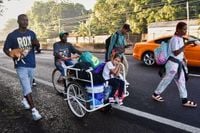Before dawn broke on October 1, 2025, the streets of Tapachula, a city perched near Mexico’s border with Guatemala, filled with the sounds of footsteps and quiet determination. About 1,200 migrants, most of them Cubans but also including people from Honduras, Ecuador, Brazil, and Haiti, set out walking north. Their destination: Mexico City. Their hope: to finally legalize their immigration status and find work, after months—sometimes years—of waiting in limbo on Mexico’s southern frontier.
According to the Associated Press, this group’s journey marks a notable shift from previous migrant caravans. In the past, such caravans often aimed for the United States, hoping to cross the border and seek asylum. But this time, the goal is different. The migrants aren’t charging toward the U.S.; instead, they’re trying to pressure Mexican authorities to speed up their asylum processes so they can leave southern Mexico, where opportunities for work are painfully scarce.
For many, the wait in Tapachula has been agonizing. Cuban migrant Losiel Sánchez and his wife arrived in the city last November, full of hope that a U.S. government app called CBP One would help them secure an appointment to cross into the United States, request asylum, and—if all went well—be paroled into the U.S. while their case was processed. But that hope vanished when former U.S. President Donald Trump ended the CBP One program. The abrupt policy change stranded tens of thousands of migrants who were already making their way north, leaving them caught between borders and bureaucracies.
“Everything is expensive and I can’t pay rent,” Sánchez told the Associated Press, echoing the frustration of many in Tapachula. “There’s no work, they don’t want to give you work if you don’t have papers.”
With the U.S. door closed, Sánchez decided to seek asylum in Mexico. But despite repeated visits to Mexico’s asylum agency, known as Comar, he and his wife still have no answer about their status. To make matters worse, Sánchez was scammed by someone posing as a lawyer who promised to expedite their process. The scam left them with less money and no closer to legal status. Now, Sánchez hopes that by joining the march to Mexico City, he might have better luck—and perhaps, finally, a chance to work and pay rent.
Anery Sosa, another Cuban migrant, has been stuck in Tapachula for a year. Her own attempt to secure asylum was derailed when someone stole her documents. Sosa, who has a daughter with a Mexican citizen, longs to find someone who can care for her child during the day so she can work. But with her husband’s earnings alone, they can’t cover rent and food. “Her husband’s earnings alone don’t cover rent and food,” Sosa explained, painting a picture of daily struggle that’s all too familiar for many migrants in the city.
This group of 1,200 migrants didn’t have a single leader. Instead, they organized themselves over social platforms, rallying out of frustration and a shared desire to walk their way out of southern Mexico’s stagnation. This grassroots approach stands in contrast to earlier, more organized caravans. Over the past year, similar groups have taken to the roads in hopes of drawing attention to their plight and forcing action from Mexican authorities.
Unlike previous caravans, which often made headlines for their size and their stated goal of reaching the United States, this year’s groups have a more localized demand: they want Mexican officials to speed up the asylum process and allow them to leave the south, where job opportunities are nearly nonexistent. According to the Associated Press, the migrants’ hope is that by walking en masse, they’ll pressure the government to act—perhaps even offering documentation or transportation after a few days on the road, as has happened in the past.
The situation in Tapachula has grown increasingly tense as thousands of migrants wait for months, sometimes longer, for their asylum applications to be processed. The city, already strained by the influx, offers few jobs and little support. Many migrants, like Sánchez and Sosa, find themselves stuck in a cycle of poverty and uncertainty, unable to move forward or back. The cost of living is high, and without legal papers, most employers won’t hire them. Some, desperate for help, fall victim to scams and theft—a cruel twist in an already difficult journey.
Mexico’s asylum agency, Comar, has been overwhelmed by the sheer number of applications. The backlog leaves many in limbo, with little information about when—or if—their cases will be resolved. For some, the only option seems to be collective action: walking together to Mexico City, where they hope to catch the attention of national authorities and, perhaps, secure the documentation they need to start new lives.
Mexican authorities have a mixed record when it comes to handling these migrant marches. In the past, they’ve sometimes allowed groups to walk for a few days before stepping in to offer help with paperwork or even transportation. This approach, while pragmatic, has done little to address the root causes of the migration crisis or the bureaucratic bottlenecks that keep so many migrants trapped in southern Mexico.
The current march is a reflection of both desperation and resilience. The migrants know the risks—they face long days on foot, uncertain weather, and the constant threat of being turned back or detained. But for many, the alternative is simply unacceptable: more months spent waiting in Tapachula, unable to work or provide for their families.
For those following the story, it’s hard not to wonder what will happen next. Will the group make it to Mexico City? Will Mexican authorities intervene, as they have before, or will this march finally force a change in policy? The answers remain uncertain. What is clear, however, is that the migrants’ journey is about more than just paperwork—it’s about dignity, hope, and the relentless pursuit of a better life.
As the sun rose over Tapachula, the 1,200 migrants pressed on, their footsteps echoing a simple, urgent demand: the right to be seen, to be heard, and to build a future beyond the border’s shadow.






